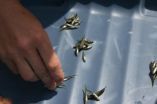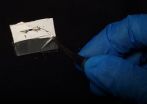(Press-News.org) New data presented today at the European League Against Rheumatism Annual Congress (EULAR 2014) show that ultrasound-guided injections of growth factors-containing platelet-rich plasma (PRP) are no more effective in treating recently developed epicondylitis than injections of saline.1
Lead researcher, Patrick Le Goux of the Hôpitaux Universitaires Paris Ile-de-France Ouest, France, commented, "while PRP injections were shown to have no inherent benefit in the treatment of epicondylitis, what is exciting is that pain scores in both treatment groups decreased significantly over the course of the trial. The healing process is stimulated by the echo-guided injection of a substance and/or by the own effect of the needle (needling); the injections stimulate the process of tendon repair through an irritation effect, a technique known as prolotherapy."
Epicondylitis is a painful condition that occurs when the tendons in the elbow are overworked, usually by repetitive motions of the wrist and arm. In lateral epicondylitis (also referred to as tennis elbow), the pain occurs primarily where the tendons of the forearm muscles attach to the bone on the outside of the elbow2 and medial epicondylitis (also referred to as golfer's elbow) where the tendons attach to the bone on the inside of the elbow. The pain of both conditions may also spread to the forearm and wrist.3
Although a large number of treatments – including physiotherapy, corticosteroid injections, and non-steroidal anti-inflammatory drugs – are used to treat epicondylitis, there is no consensus on which is the most effective.4 Recently, local injections of growth factors containing platelet-rich plasma (PRP) were proposed as a new therapeutic technique for boosting tendon repair,5 with ultrasound guidance of the intra-tendinous injections used to optimise the procedure.6
In this latest study, patients with recent onset epicondylitis (pain ≤3 months), confirmed by MRI and/or ultrasound, were treated with two ultrasound-guided injections at 4 week intervals. Patients received
either PRP (ACP®, Arthrex) or saline solution and were monitored by an independent clinical evaluator, blinded to the treatment at baseline, one, three, six and 12 months.
The primary evaluation criterion was the relative improvement from baseline to six months in pain score (PS) on the visual analogue scale (0-10). The secondary criteria was the assessment of pain (yes/no) on isometric contraction of the second radial and of the muscle of the posterior forearm (extensor digitorum communis), the Roles-Maudsley score* (1-4), the proportion of asymptomatic patients (PS ≤1) at six and 12 months follow-up and the proportion of patients with persistent pain (PS >2) at 12 months follow-up. Fifty patients were included in the study, 25 in each arm, but only 22 in both groups completed the follow up at 12 months.
At a six-month follow-up, no statistically significant difference was found between the groups for mean relative improvement in pain (ACP 54.7% vs. control 63.6%; p=0.24) and no statistically significant difference was found for the secondary criteria. In the two groups, the pain score decreased significantly between two consecutive visits from 6.8±0.8 (PRP) and 7±1 (control) at baseline to 2.5±1.6 (PRP) and 2.1±1.6 (control) at 6 months and 1.65±1.5 (PRP) and 1.8±2.1 (control) at 12 months. At six months, 34% of all patients were asymptomatic; 66% were asymptomatic at one year. The proportion of patients with persistent pain at 12 months was 23.8% in both groups. No adverse effects were observed.
INFORMATION:
Abstract Number: OP0013
NOTES TO EDITORS: For further information on this study, or to request an interview with the study lead, please contact us via: EULAR congress
Press Office: Room 104, Palais des congrès de Paris
Email: eularpressoffice@cohnwolfe.com
Onsite tel: +44 (0) 7880 173209
Twitter: @EULAR_Press
About EULAR
The European League Against Rheumatism (EULAR) is an umbrella organisation which represents scientific societies, health professional associations and organisations for people with rheumatic diseases throughout Europe.
* The Roles-Maudsley score is a subjective 4-point patient assessment of pain and limitations of activity (1 = excellent result with no symptoms following treatment; 2 = significant improvement from pre-treatment; 3 = patient somewhat improved; 4 = poor, symptoms identical or worse than pre-treatment).
EULAR aims to promote, stimulate and support the research, prevention, and treatment of rheumatic diseases and the rehabilitation of those it affects.
With 45 scientific member societies, 35 People with Arthritis and Rheumatism in Europe (PARE) organisations, 17 health professionals associations and 26 corporate members, EULAR highlights the importance of combating rheumatic diseases through both medical means and patient care.
EULAR 2014 is set to be the biggest rheumatology event in Europe with almost 14,000 scientists, physicians, allied health professionals and related audiences in attendance from 130 countries. Over the course of the congress there will be 302 oral and 1,806 poster abstract presentations, 155 sessions, 725 lectures, 33 poster tours with 421 invited speakers.
To find out more about the activities of EULAR, visit: http://www.eular.org
1 Le Goux P, Montalvan B, Leparc JM et al. Treatment Of Epicondylitis By Ultrasound-Guided Local Injections Of Autologous Conditioned Plasma (Acp®): A Double-Blind Placebo-Controlled Randomized Clinical Trial With 1-Year Follow-Up. EULAR 2014; Paris: Abstract OP0013
2 Mayo Clinic. Diseases and Conditions: Tennis elbow: Definition. http://www.mayoclinic.org/diseases-conditions/tennis-elbow/basics/definition/con-20043041 [Accessed 05/06/2014]
3 Mayo Clinic. Diseases and Conditions: Golfer's elbow: Definition. http://www.mayoclinic.org/diseases-conditions/golfers-elbow/basics/definition/con-20027964 [Accessed 05/06/2014]
4 Olaussen M, Holmedal O, Lindbaek M et al. Treating lateral epicondylitis with corticosteroid injections or non-electrotherapeutical physiotherapy: a systematic review. BMJ Open 2013;3:e003564 doi:10.1136/bmjopen-2013-003564
5 Peerbooms JC, Sluimer J, Bruijn DJ, Gosens T. Positive effect of an autologous platelet concentrate in lateral epicondylitis in a double-blind randomized controlled trial: platelet-rich plasma versus corticosteroid injection with a 1-year follow-up. Am J Sports Med 2010; 38(2): 255-62
6 Chiavaras MM, Jacobson JA, Semin Musculoskelet Radiol 2013; 17(1): 85-90
Tendon stimulation the key to repair in 'tennis elbow'
Saline injections as effective as platelet-rich plasma injections
2014-06-11
ELSE PRESS RELEASES FROM THIS DATE:
Higher disease activity scores in obese RA patients
2014-06-11
A new study presented today at the European League Against Rheumatism Annual Congress (EULAR 2014) showed that obese patients with rheumatoid arthritis (RA) have higher DAS (disease activity) scores than non-obese patients, irrespective of their disease stage.1 With clinical remission as the ultimate therapeutic goal in RA,2 several studies have demonstrated that treatment to target – a treatment approach guided by its impact on reducing DAS scores – is more effective in lowering disease activity and, ultimately, reaching remission than usual care.3-7 Because obese patients ...
Newly discovered paddle prints show how ancient sea reptiles swam
2014-06-11
Trackways formed on an ancient seabed have shed new light on how nothosaurs, ancient marine reptiles that lived during the age of the dinosaurs, propelled themselves through water. The evidence is described by a team from Bristol and China in Nature Communications today.
During the Mesozoic, 252-66 million years ago, the seas were ruled by a variety of marine reptiles. One of the earliest groups were the nothosaurs, voracious semi-aquatic hunters with elongate bodies and paddle-like limbs. They were the top predators of the Triassic coasts, some 245 million years ago.
Their ...
Forest loss starves fish
2014-06-11
Debris from forests that washes into freshwater lakes supplements the diets of microscopic zooplankton and the fish that feed off them – creating larger and stronger fish, new research shows.
The researchers warn that, as forests are eroded through human activities such as logging, the impacts will be felt in aquatic as well as terrestrial food chains.
In fact, the study was conducted at a Canadian lake chosen because it had suffered ecological disaster during the mid-20th century: acid rain as a result of the local nickel smelting industry.
Despite moves to reduce ...
Sports teams may lose out from having 'too much talent'
2014-06-11
As the FIFA World Cup kicks off and the NBA finals "heat" up, new research suggests that there is such a thing as having too much talent on a sports team. The research indicates that, after a certain point, the addition of more superstar talent to a team can actually be detrimental, resulting in poorer team performance.
The findings are forthcoming in Psychological Science, a journal of the Association for Psychological Science.
The research, led by INSEAD Professor Roderick Swaab, showed that the presence of too many individuals with top talent can undermine players' ...
Nearby satellite galaxies don't fit standard model
2014-06-11
Satellite dwarf galaxies at the edges of the Milky Way and neighboring Andromeda defy the accepted model of galaxy formation, and recent attempts to pigeon-hole them into the model are flawed, an international team of scientists reports.
The mismatch raises questions about the accuracy of the standard model of cosmology, which is the widely accepted paradigm for the origin and evolution of the universe, the astrophysicists say.
A preprint of the research paper, accepted for publication by the Monthly Notices of the Royal Astronomical Society, is online at http://arxiv.org/abs/1406.1799.
The ...
Map of universe questioned; dwarf galaxies don't fit standard model
2014-06-11
Dwarf galaxies that orbit the Milky Way and the Andromeda galaxies defy the accepted model of galaxy formation, and recent attempts to wedge them into the model are flawed, reports an international team of astrophysicists.
David Merritt, professor of astrophysics at Rochester Institute of Technology, co-authored "Co-orbiting satellite galaxy structures are still in conflict with the distribution of primordial dwarf galaxies," to be published in an upcoming issue of Monthly Notices of the Royal Astronomical Society. A pre-print of the paper is available online at http://arxiv.org/abs/1406.1799.
The ...
Improvements in MRIs, other image-detection applications on the horizon
2014-06-11
LIVERMORE, Calif. — Researchers at Sandia National Laboratories, along with collaborators from Rice University and the Tokyo Institute of Technology, are developing new terahertz detectors based on carbon nanotubes that could lead to significant improvements in medical imaging, airport passenger screening, food inspection and other applications.
A paper in Nano Letters journal, "Carbon Nanotube Terahertz Detector," debuted in the May 29 edition of the publication's "Just Accepted Manuscripts" section. The paper describes a technique that uses carbon nanotubes to detect ...
Experts unlock key to blood vessel repair
2014-06-11
Scientists from the University of Leeds have found a way to restore the function of damaged blood vessel repairing cells, in a potentially important step for the future treatment of heart disease.
The research, part-funded by the British Heart Foundation (BHF), could also pave the way for new targets for drug development in the fight against heart disease.
The findings have also identified a potential reason why South Asian men in the UK experience an increased risk of heart disease.
Led by Dr Richard Cubbon in the School of Medicine, the research team studied cells ...
New research could provide key to overcoming resistance to HER2 targeted cancer treatments
2014-06-11
Dublin, Ireland, June 11th, 2014 – Scientists from the School of Pharmacy & Pharmaceutical Sciences, Trinity College Dublin have made a significant discovery of a new biomarker which may help overcome resistance to newer and more targeted anti-cancer drugs, such as Herceptin, for HER2 positive cancers. These findings may also help the early identification of patients who will benefit more from these treatments.
The researchers, led by Professor Lorraine O'Driscoll, Associate Professor of Pharmacology, Trinity, studied breast cancer cells and their extracellular vesicles ...
International team unearths genetic risk factor for type 2 diabetes in Latin American populations
2014-06-10
In the largest study of its kind published to date, an international team of researchers in Mexico and the United States has discovered a strong genetic risk factor for type 2 diabetes that primarily affects Latin American patients, but is rare elsewhere. The work further characterizes a gene called HNF1A, responsible for a rare, inherited form of diabetes against which a widely available and inexpensive class of drugs is highly effective. The discovery offers important new clues about the population genetics of type 2 diabetes in Latin American populations, and suggests ...
LAST 30 PRESS RELEASES:
School meals could unlock major gains for human and planetary health
Menopause hormone therapy does not appear to impact dementia risk
Signature patterns of brain activity may help predict recovery from traumatic brain injury
Dresden study uncovers new key mechanism in cancer cells
New species are now being discovered faster than ever before, study suggests
Cannabis-based products show limited short-term benefit for chronic pain, with increased risk of adverse effects
Cannabis products with more THC slightly reduce pain but cause more side effects
Clearing the brain of aging cells could aid epilepsy and reduce seizures
Brain injuries linked with potential risk of suicide, new study finds
New technique lights up where drugs go in the body, cell by cell
New study finds movement of fishing fleets can reveal shifts in marine ecosystems
Embargoed: New evidence points to potential treatment for vascular dementia
Study uncovers disrupted brain balance in alcohol dependence
Working in groups can help Republicans and Democrats agree on controversial content moderation online
Structural findings reveal how distinct GPCR ligands create different levels of activation
Anything-goes “anyons” may be at the root of surprising quantum experiments
UC review: Maximizing workplace opportunity for veterans
From generation to complex control: Metasurfaces make perfect vortex beams "within reach"
Thin-film lithium niobate-based detector: recent advances and perspectives
Exploring why some people may tend to persistently make bad choices
How cells balance their protein levels
Nirsevimab vs RSVpreF vaccine for RSV–related hospitalization in newborns
Effectiveness and impact of maternal RSV immunization and nirsevimab on medically attended RSV in US children
AI gives scientists a boost, but at the cost of too many mediocre papers
Next-generation vision model maps tree growth at sub-meter precision
Genes aren’t destiny for inherited blindness, study shows
MIT study: High-fat diets make liver cells more likely to become cancerous
Exposure to multiple fine particulate matter components and incident depression in the US Medicare population
Risk of burdensome health care spending over time in the US
Nirsevimab against hospitalizations and emergency department visits for lower respiratory tract infection in infants
[Press-News.org] Tendon stimulation the key to repair in 'tennis elbow'Saline injections as effective as platelet-rich plasma injections



